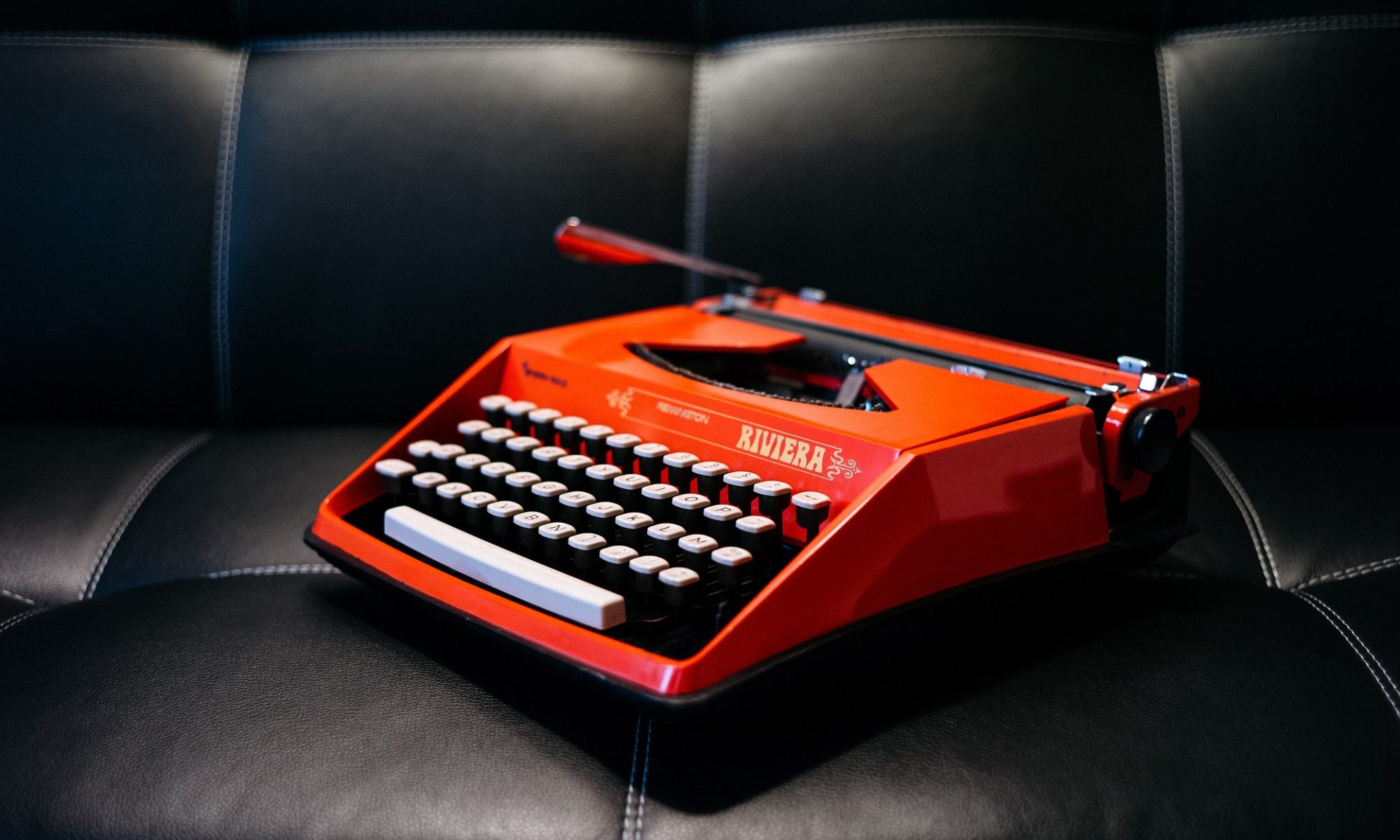More than 500 Canadian art professionals have formed a new coalition to call on the government to take a balanced approach to copyright reform. Appropriation Art: A Coalition of Arts Professionals, includes arts organizations from Alberta, BC, Quebec, Ontario, and Saskatchewan along with hundreds of artists from across Canada. The remarkable list features the President of Carfac Ontario and winners of numerous art awards including eight Governor General’s Awards in Visual and Media Arts.
The group identifies three issues in their letter to Ministers Oda and Bernier: fair access, certainty of access for creative purposes through a fair use provision, and no support for anti-circumvention legislation. There is something very exciting happening here: musicians, privacy groups, students, and now artists are standing together against anti-circumvention legislation and for balanced copyright. These are voices that until now have been missing from the copyright reform debate. With their active involvement, they have affirmed that the DMCA-like provisions have little to do with support for creators or creativity. Rather, they are provisions designed to support a small cadre of largely foreign-backed industry groups without representing the real needs of Canada’s own artistic and cultural communities. It is time for the government to listen to its own artists, who are forcefully speaking in their own name.
Michael Geist – Hundreds of Canadian Artists Call for Balanced Copyright
Leni Kae – Abstract/Cubist
Some really beautiful stuff on this site. And she’s got a really good artist’s statement:
“Leni’s attraction to the abstract arts is the ability to see and represent a world that is absent from the boundaries and expectations of our physical senses; a world coloured by personal passions, emotions, and dreams.
“Cubist and surrealist influences are largely evident in the majority of her work.
“She is drawn on the one side to the fluidity of the surrealist form and its ability to express pure passion and dream. Concepts of love, torment, and sexuality, are subjects she finds easily explored through the application of this style. The challenge in such works is to see and understand the feelings that unite us as human beings.”
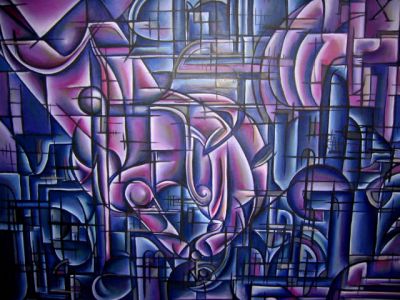
Leni Kae ..
Dee Adams – Abstract Painter (Sydney, NSW)
Got a nice style. One that’s getting pretty close to something I was thinking about.
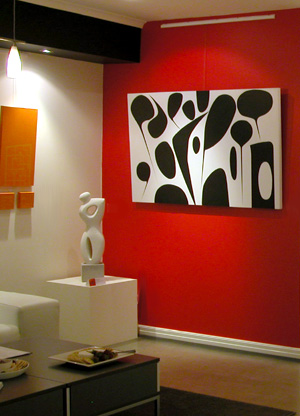
Artists Online : Dee Adams
Dee Adams’ history as an artist spans the worlds of traditional art, graphic design, advertising design, and technical illustration. Born in the US, Dee spent time studying art and biochemistry at Ithaca College and Cornell University originally pursuing a career as one of the top scientific technical illustrators in her field. Seduced by the world of graphic design and advertising, Dee went on to San Francisco to work for such companies as Yahoo!, Microsoft, Disney, and various media and film studios.
It wasn’t until several years ago that Dee made her way back onto the traditional art scene with shows in both San Francisco and New York. Her style has been described as contemporary bold minimalism with an edginess inspired by technology.
Some neat ideas for artists
I found this on an artist’s website, and it looks like a good list of services to provide if you’ve got a lot of art which isn’t moving. I suppose it’s always important to consider all current contracts you have with galleries or studios, as the following list could impact on your existing agreements:
- Trade discounts on more than 2 pieces
- Rental schemes for show homes
- Collections for galleries and retail outlets
- Free sourcing of artwork
- Free art on loan service in return for promotional presence
I’d be interested to see if CARFAC has any similar lists, with some pricing models.
Buying some canvases
Been looking at some different sizes of canvases for my next painting project. I was thinking something in the range of 91x91cm (3’x3′) or 91x122cm (3’x4′). These look like good sizes that would still fit into my car, if I needed to transport them. I really like the idea of using canvas. It’s so much lighter than the masonite projects. I’m a little worried about whether I can knock them around as much as the masonite projects, though.
Now I just need to consider pre-stretched, pre-gessoed canvas vs. doing it myself. The benefits are easy to see for pre-stretched:
- everything’s pretty much done for me
- pre-stretched
- pre-gessoed
- properly assembled
The benefits of doing it myself are also compelling:
- I don’t feel like a real artist unless I do it myself
- the canvas materials are cheaper
- I like black gesso, not white
- I can make whatever size I want
It boils down to one thing, really. Am I too lazy to do this myself, or do I feel like I could do this better than the art supply store would. I’m still thinking….
Queen St.Yoga Exhibition Pics
Here are some pictures of the exhibit at Queen St. Yoga in downtown Kitchener. The studio is located at 44 Queen St. S., Kitchener, ON (just above Encore Records). They’ve got twelve of my paintings, and have installed nine of them. They are looking for places to display the other three at the moment. This exhibit is part of the Kitchener Available Space Art Project.
The paintings will be on display for the next 2-3 months. QSY has offered to extend this show after ASAP is finished.
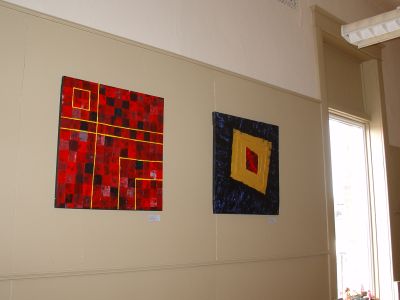
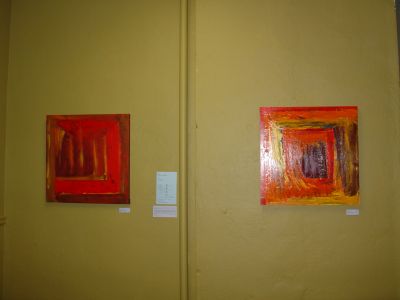
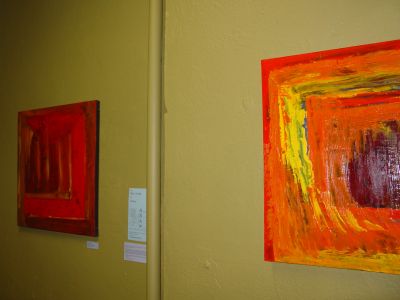
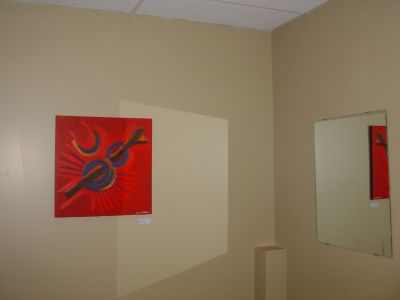
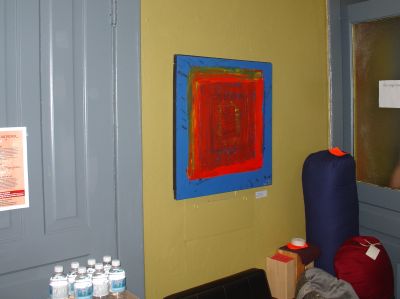
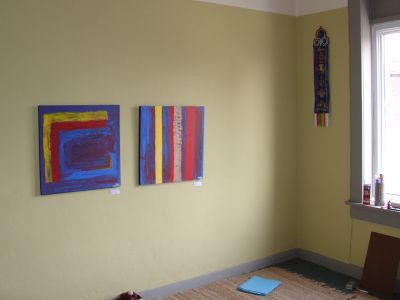
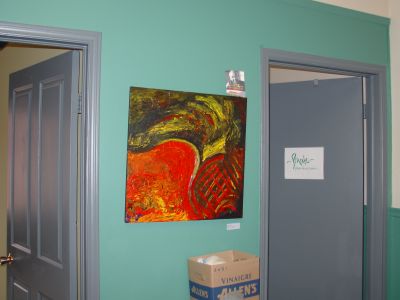
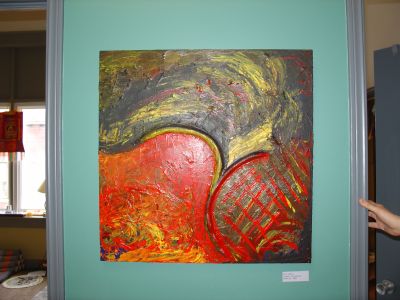
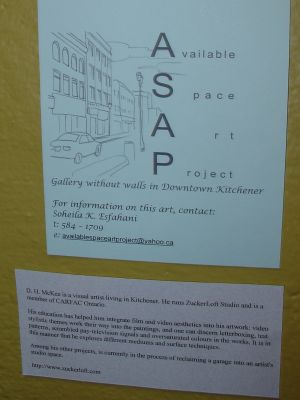
Art at the Yoga Studio
I delivered some more paintings to the yoga studio yesterday. There was a bit of a logistical problem getting the paintings delivered, solved by the new crates I had made. The crates are a great design, but I’ve got to go back to the manufacturer to discuss some adjustments in the construction. They used a glue gun to fasten the seams, and that stuff doesn’t work well when it’s cold, or when the joints/seams are under stress — which makes it useless for this kind of crate. Also, the foam cushioning wasn’t cut to the right size, so none of the paintings fit until I cut away some of the foam, which throws into question why I’m paying so much for the foam padding. One other problem lies in the hand-holds: they essentially cut away parts of the side panels, to allow you to put your hands in and lift the box. This may have been more economical than having external handles (as per my design), but there’s no cushioning. When the box is fully loaded, they are about 15-20kg, making it kind of heavy, and that coroplast digs into your hands.
The studio has already been showing my initial two paintings in their lobby, so that’s a big bonus. I was thrilled to see them hanging in such a high-traffic area. Unfortunately, most of the studio’s walls are concrete, which makes it impossible to hang anything on them. The ceilings are tin, or are riddled with duct-work, and are about 6m high, so hanging from the ceiling isn’t going to work either. After some scouting around the place, it looks like I might be able to get another five paintings into the space, in various nooks, so it’s not a total write-off. I’ll be back in on Sunday with some business cards and some painting nametags (and pricetags).
I’ll see if I can get some pictures of the space and post them. I’m also going to ask if I can rent/borrow the space for an art opening. We’ll see how it goes.
How to Write an Artist’s Statement
An artist’s statement is a short piece written by the artist to accompany a particular painting or group of paintings. An artist’s statement shouldn’t be dismissed as insignificant or dashed out in a hurry as it’s a vital selling tool, promoting and explaining your work to people looking at your paintings, whether they’re potential buyers, exhibition curators, critics, fellow artists, or casual browsers.
At its best, an artist’s statement reads easily, is informative, and adds to your understanding of the artist and the painting. At its worse, an artist’s statement is difficult to understand or rambles on, is pretentious, and irritates rather than informs (or, even, provokes laughter).
How to Write an Artist’s Statement
3rd Person Artist Statement (take one)
D. H. McKee’s artistic education stems from a Bachelor’s degree in English and Film Studies. He is a multi-skilled artist who works with painting, mixed media, journaling, digital photography, music, and video. He has a range of experience in various media, but painting is his first and foremost output; painting is a way of expressing ideas and emotions which cannot be formed through words or sound.
His education has helped him integrate film and video aesthetics into his artwork: video stylistic themes work their way into the paintings, and one can discern letterboxing, test patterns, scrambled pay-television signals and oversaturated colours in the works. It is in this manner that he explores different mediums and surface techniques.
Paintings are created quickly, passionately. They are assembled adjacent to thought and emotion, and are influenced by music, noise, television, and computers. The highly decorative images are richly textured and overflowing with colour. They are a combination of cubist and surrealist influences on non-representational abstract forms — essentially the interpretation of different external stimuli. The image dictates its final form, resulting in a surprising, unpredictable finished product.
Gallery 101 – Deadline: April 15, 2006
Gallery 101 hosts approximately eight exhibitions each year, as well as many video presentations, lectures, performances and other activities. Artists and curators working in any media or discipline are eligible to apply. All submissions must be accompanied by a self-addressed, stamped envelope. Submissions should include the following:
– a project description or proposal
– a current CV
– an artist’s statement
– support material with an identification list (including 10 slides, video/audio cassettes/cd, etc.) Please do not send original works. No fax or email submissions will be accepted. For more information, please contact info@gallery101.org
Gallery 101 is committed to paying artists’ fees in accordance with CAR/FAC recommendations.
Director/Curator: Jessie Lacayo
Gallery 10
236 Nepean Street
Ottawa, Ontario
K2P 0B8
Canada
info@gallery101.org
Floor plan: http://www.gallery101.org/downloads/G101_Floorplan_04.pdf
